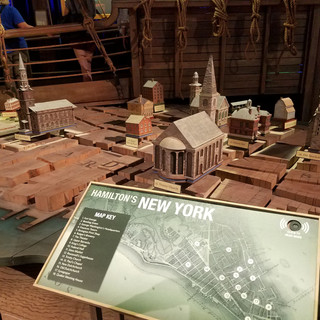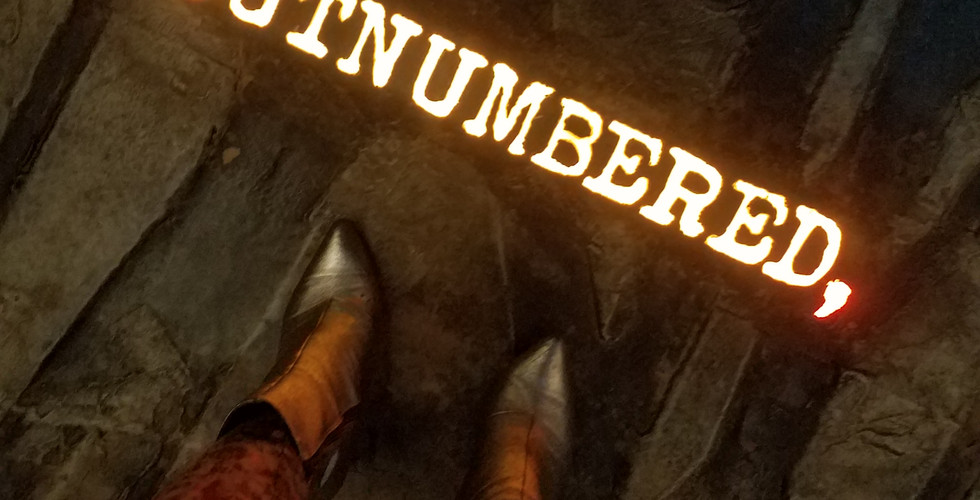This past Tuesday, I was lucky enough to get tickets to the new Hamilton: The Exhibition in my hometown of Chicago! With two friends - @sadieshimmers and @scarlett_cherrybomb - in tow who are very aware of my obsession (and even share in it a bit themselves), we set out to explore the Exhibition.
(And, yes, we did it in while bounding as the Schuyler Sisters! How could we resist?)

With no particular expectations, and armed with plenty of knowledge about Hamilton's life, I never anticipated that the experience would "Blow Us All Away" as much as it did.

After sitting through a short introductory video hosted by Phillipa Soo and Lin-Manuel Miranda, we made our way into a large room that illustrated the beginning of Hamilton's life. This room told the story of the transatlantic slave trade in the British West Indies - the place where Hamilton was born and struggled to survive. I shouldn't have been surprised at how honest the Exhibition would be about the non-erasure of historical events, but because many museum are only starting to tell these stories so honestly it's not regular in my experience.
We moved on, the room opening up into portraits of famous players in the Revolution covering the walls, and a model of Hamilton's New York being the centerpiece of it all. When you walked into the room, you could see the model from behind. My nerdy detailed self centered in on Trinity Church - though I could only make out the barest of details. (Can you blame me?) Admittedly, I rushed through the portraits section to get down to the floor and see the model.

Being an extreme map nerd, I couldn't get over the fine details put into a model of this magnitude. Though you really can't make it out in these photos, the bottom of the display was painted to look like a historical map; raised to highlight the important streets and landmarks. The aesthetics of this section had such high quality, and I'd love to see this idea applied to other museum exhibits in the near future.

Much of what we know about Hamilton and his associates during the Revolution comes from their own words. Surviving letters and records of correspondence between them is what is used to establish both a historical narrative and the narrative Lin-Manuel Miranda laid out in the musical.
This room was the physical illustration of said letters. The room ranks high on my list of those in the Exhibition that are smaller but impactful. When you lay eyes on it for the first time, it stops you in your tracks. You are compelled to know the details of what it's all about. History told in the way of piquing curiosity is essential. It is all about grabbing people who may have not been previously knowledgeable and engaging them. Much like the musical itself.

I look like peak museum nerd in this photo. I forgot to take my tour headset off that you're given for the Exhibition's audio narrative, and the smile on my face is just a little too big. This photo accurately captures my overhanging mood while exploring the Exhibition.
The fine details of the Revolutionary War were laid out in several following rooms. Some were oriented to showing the massive amount of British that initially came to the Colonies' shores. Another highlighted General Washington and his associated leaders. (This included Native American leader Thayendanegea - aka Joseph Brant - who I knew little about before this.) The last few drove home the impact on the Revolutionary soldiers - the cold, the hunger, the almost hopeless state they existed in before the tide of the war turned.

We then moved on to my favorite room in the entire Exhibition. This is a place where the war has been won, and everyone is celebrating the marriage of Eliza and Alexander Hamilton.
There was so much going on in this room. It's hard to accurately describe it all. It was full of gilded historical figures - some of which you've heard about, and some others that you might not have. These three are the recreations of the Schuyler Sisters - Angelica, Eliza, and Margarita (aka Peggy).

Along with Hamilton (I had to sneak a dance in with my best historical boy), you could find Lafayette, Laurens, and the other expected players could be found around the room.
(They made a point of joking that Burr definitely wasn't in attendance!)

As we know from history (and the musical) post-war, King George III was not a happy camper. Though he is a footnote in the Exhibition, there is one room dedicated to him, a summary of his role in the Revolution, and a bit about the Queen of England at this time - someone that often gets overlooked in the narrative. (I joke, but perhaps it's because she has one of those almost impossible to pronounce names that has been commonplace among royalty for almost forever?)
The next few rooms were set up with stunning visuals that drove the point of in-state fighting post-war. The decision making processes on how to set up what would become the United States was fraught with sharp debate. (There is a literal room that shows it to be a circus! I could not have described it better myself.)
The cherry on top to this part of the story is the election of 1800. Slight corrections and elaborations are made to this part of the story as it is related in the musical. It is also at this point where it is driven home that some sort of stability has finally been established in the Colonies.
As we drew nearer to the end of the Exhibition, they gave us ample warning as to what was coming - the showdown between Hamilton and Burr. Strangely, this is the singular room where Aaron Burr is at all really highlighted. Where he is a footnote in the earlier narrative, the story cannot ignore him any longer. The sad ending to the story is driven home by a display on the wall that reads, "Hamilton lived 32 hours after leaving his home to duel Burr. Burr lived 32 years after shooting and killing Hamilton."

I couldn't confirm this, but the statues of Hamilton and Burr in this room are either perfect replicas of or on loan from the Alexander Hamilton Room at the Museum of American Finance in NYC.

As the Exhibition wound down, it drove home the point of Hamilton's legacy - a core theme in the musical itself. Eliza's contributions to telling his story are highlighted along with a family tree of a portion of his descendants, and a station that encouraged you to tell "your story".
Whether a fan of the musical or just this period in American History, I would recommend Hamilton: The Exhibition to anyone passionate about this story. Tickets for the Exhibition are discounted for a group of four or any school group. Visit the official site for even more photos and full info about how you can go on your own adventure through this unique experience.
.png)





































